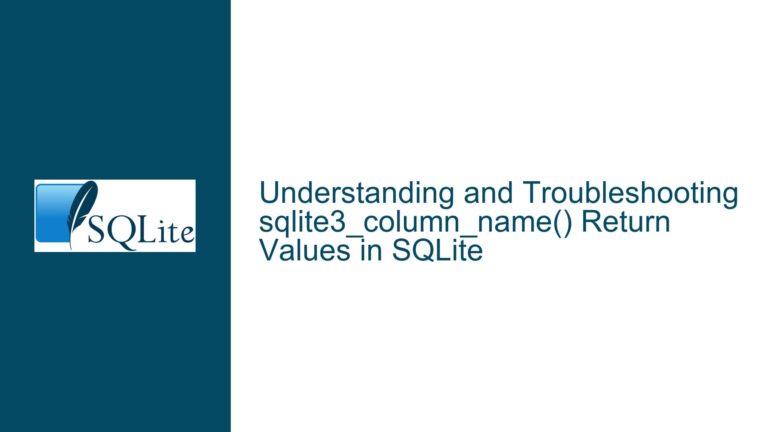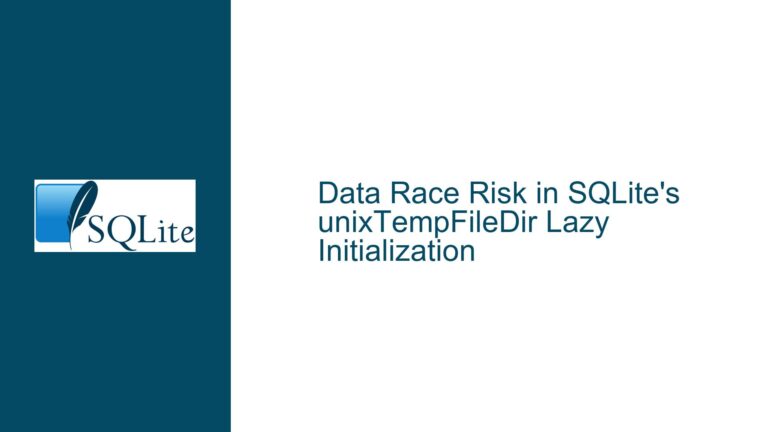Handling Out-of-Memory Errors in SQLite Virtual Tables with VSV Extension
Out-of-Memory Errors When Accessing VSV Virtual Tables
When working with SQLite virtual tables, particularly those created using the VSV (Variably Separated Values) extension, one of the most common issues that users encounter is the dreaded "out of memory" error. This error typically occurs when attempting to query a virtual table that has been created with insufficient or incorrect parameters. The VSV extension is a powerful tool for reading and processing CSV, TSV, and other variably separated value files, but it requires careful configuration to avoid memory-related issues.
The VSV extension allows users to define virtual tables that can read data from files with custom field and record separators. This flexibility is incredibly useful for handling a wide range of data formats, but it also introduces complexity that can lead to errors if not properly managed. One of the key parameters that must be correctly specified is the columns parameter, which defines the number of columns in the virtual table. If this parameter is omitted or incorrectly set, SQLite may attempt to allocate an excessive amount of memory, leading to an out-of-memory error.
In addition to the columns parameter, other parameters such as filename, header, fsep, and schema must also be correctly specified to ensure that the virtual table is properly initialized and that memory is allocated efficiently. Misconfigurations in any of these parameters can lead to memory allocation issues, particularly when dealing with large files or complex schemas.
Misconfigured Virtual Table Parameters Leading to Memory Allocation Issues
The primary cause of out-of-memory errors when working with VSV virtual tables is the misconfiguration of key parameters during the creation of the virtual table. The columns parameter is particularly critical, as it directly influences how SQLite allocates memory for the virtual table. If the columns parameter is omitted, SQLite will attempt to determine the number of columns by parsing the first record of the input file. While this may work for small files, it can lead to significant memory allocation issues when dealing with larger files or files with complex structures.
Another common cause of memory-related issues is the incorrect specification of the schema parameter. The schema parameter defines the structure of the virtual table, including the names and data types of the columns. If the schema is not correctly defined, SQLite may allocate memory based on incorrect assumptions about the structure of the data, leading to out-of-memory errors. Additionally, if the header parameter is incorrectly set, SQLite may misinterpret the first row of the input file as data rather than a header, leading to further memory allocation issues.
The fsep (field separator) and rsep (record separator) parameters also play a crucial role in memory allocation. If these parameters are not correctly specified, SQLite may misinterpret the structure of the input file, leading to incorrect memory allocation. For example, if the fsep parameter is set to a tab character (\t) but the input file uses a different separator, SQLite may incorrectly parse the file, leading to memory allocation issues.
Finally, the size of the input file itself can contribute to memory-related issues. Large files require more memory to process, and if the virtual table is not correctly configured, SQLite may attempt to allocate more memory than is available, leading to out-of-memory errors. This is particularly true when working with files that contain a large number of columns or records.
Correctly Configuring VSV Virtual Tables to Prevent Out-of-Memory Errors
To prevent out-of-memory errors when working with VSV virtual tables, it is essential to correctly configure all relevant parameters during the creation of the virtual table. The following steps outline the key considerations and best practices for configuring VSV virtual tables to avoid memory-related issues.
Step 1: Specify the columns Parameter
The columns parameter is one of the most critical parameters when creating a VSV virtual table. This parameter defines the number of columns in the virtual table and directly influences how SQLite allocates memory. If the columns parameter is omitted, SQLite will attempt to determine the number of columns by parsing the first record of the input file. While this may work for small files, it can lead to significant memory allocation issues when dealing with larger files or files with complex structures.
To avoid out-of-memory errors, always specify the columns parameter when creating a VSV virtual table. The value of the columns parameter should match the number of columns in the input file. For example, if the input file contains 12 columns, the columns parameter should be set to 12:
CREATE VIRTUAL TABLE temp.zipcode
USING vsv(
filename='files/US.tsv',
header=no,
fsep='\t',
columns=12,
schema='create table x(country_code,postal_code,place_name,admin_name1,admin_code1,admin_name2,admin_code2,admin_name3,admin_code3,latitude,longitude,accuracy)'
);
Step 2: Define the schema Parameter Correctly
The schema parameter defines the structure of the virtual table, including the names and data types of the columns. If the schema is not correctly defined, SQLite may allocate memory based on incorrect assumptions about the structure of the data, leading to out-of-memory errors.
When defining the schema parameter, ensure that the column names and data types match the structure of the input file. For example, if the input file contains columns for country code, postal code, place name, and other administrative details, the schema should reflect this structure:
schema='create table x(country_code,postal_code,place_name,admin_name1,admin_code1,admin_name2,admin_code2,admin_name3,admin_code3,latitude,longitude,accuracy)'
Step 3: Set the header Parameter Appropriately
The header parameter determines whether the first row of the input file should be treated as a header row. If the header parameter is incorrectly set, SQLite may misinterpret the first row of the input file as data rather than a header, leading to memory allocation issues.
If the input file contains a header row, set the header parameter to yes or true. If the input file does not contain a header row, set the header parameter to no or false. For example:
header=no
Step 4: Specify the fsep and rsep Parameters Correctly
The fsep (field separator) and rsep (record separator) parameters define the characters used to separate fields and records in the input file. If these parameters are not correctly specified, SQLite may misinterpret the structure of the input file, leading to incorrect memory allocation.
For example, if the input file uses a tab character (\t) as the field separator, set the fsep parameter to \t:
fsep='\t'
Similarly, if the input file uses a newline character (\n) as the record separator, set the rsep parameter to \n:
rsep='\n'
Step 5: Monitor Memory Usage and Optimize Queries
Even with the correct configuration, large input files can still lead to memory-related issues. To mitigate this, monitor memory usage when querying the virtual table and optimize queries to reduce memory consumption.
For example, when querying a large virtual table, consider using the LIMIT clause to retrieve a subset of the data:
SELECT * FROM temp.zipcode LIMIT 1000;
Additionally, consider using the EXPLAIN QUERY PLAN statement to analyze the query plan and identify potential memory bottlenecks:
EXPLAIN QUERY PLAN SELECT * FROM temp.zipcode;
Step 6: Use the validatetext and nulls Parameters Wisely
The validatetext and nulls parameters provide additional control over how the VSV virtual table processes and returns data. The validatetext parameter determines whether the virtual table should validate the UTF-8 encoding of text fields, while the nulls parameter determines whether empty fields should be returned as NULL or as zero-length strings.
When working with large files, consider setting the validatetext parameter to no to reduce the overhead of validating text fields:
validatetext=no
Similarly, consider setting the nulls parameter to off to return empty fields as zero-length strings rather than NULL:
nulls=off
Step 7: Compile the VSV Extension with Appropriate Compiler Flags
When compiling the VSV extension, ensure that the appropriate compiler flags are used to avoid warnings and errors. For example, when compiling on FreeBSD, use the -std=c99 flag to ensure compliance with the C99 standard:
cc -g -fPIC -I /usr/local/include -shared -std=c99 sqliteext/vsc.c -o lib/vsc.so
Additionally, consider using the -Wall and -pedantic flags to enable additional warnings and ensure strict compliance with the C standard:
cc -g -fPIC -I /usr/local/include -shared -std=c99 -Wall -pedantic sqliteext/vsc.c -o lib/vsc.so
Step 8: Test the Virtual Table with Sample Data
Before working with large input files, test the virtual table with a small sample of data to ensure that it is correctly configured and that memory is allocated efficiently. This will help identify any potential issues before they become critical.
For example, create a small TSV file with a few rows of data and use it to test the virtual table:
CREATE VIRTUAL TABLE temp.sample
USING vsv(
filename='files/sample.tsv',
header=no,
fsep='\t',
columns=5,
schema='create table x(col1,col2,col3,col4,col5)'
);
Query the virtual table to ensure that it returns the expected results:
SELECT * FROM temp.sample;
Step 9: Handle Large Files in Chunks
When working with extremely large files, consider processing the data in chunks to reduce memory usage. For example, use the LIMIT and OFFSET clauses to retrieve and process a subset of the data at a time:
SELECT * FROM temp.zipcode LIMIT 1000 OFFSET 0;
SELECT * FROM temp.zipcode LIMIT 1000 OFFSET 1000;
SELECT * FROM temp.zipcode LIMIT 1000 OFFSET 2000;
This approach allows you to process the data in manageable chunks, reducing the risk of out-of-memory errors.
Step 10: Monitor and Optimize SQLite Configuration
Finally, monitor and optimize the SQLite configuration to ensure that it is properly tuned for handling large datasets. For example, consider increasing the cache_size and page_size settings to improve performance and reduce memory usage:
PRAGMA cache_size = -10000; -- Set cache size to 10,000 pages
PRAGMA page_size = 4096; -- Set page size to 4,096 bytes
Additionally, consider using the PRAGMA journal_mode setting to optimize the journaling mode for your workload:
PRAGMA journal_mode = WAL; -- Use Write-Ahead Logging (WAL) mode
By following these steps and best practices, you can effectively prevent out-of-memory errors when working with VSV virtual tables in SQLite. Properly configuring the virtual table parameters, monitoring memory usage, and optimizing queries will help ensure that your SQLite database performs efficiently, even when processing large and complex datasets.






